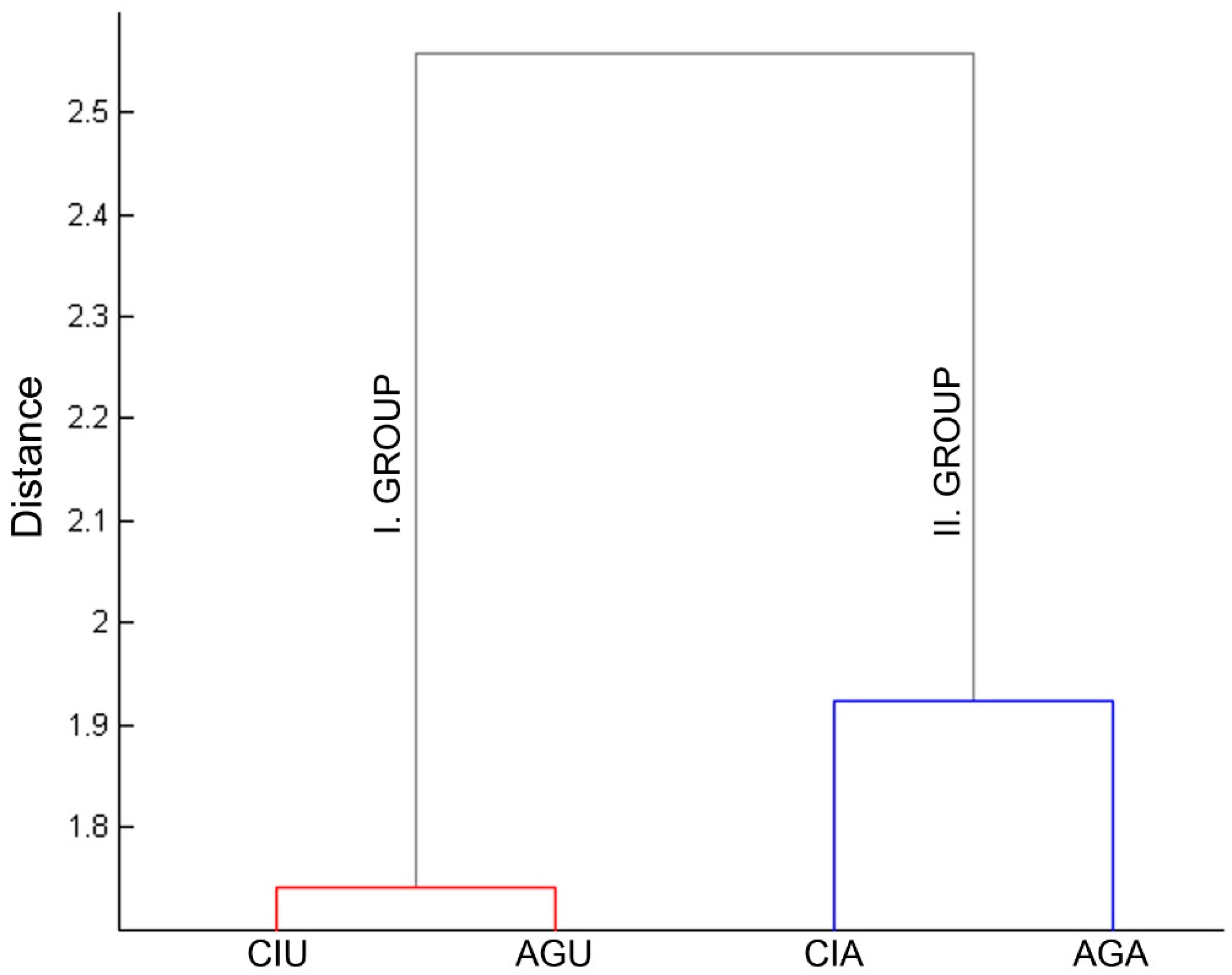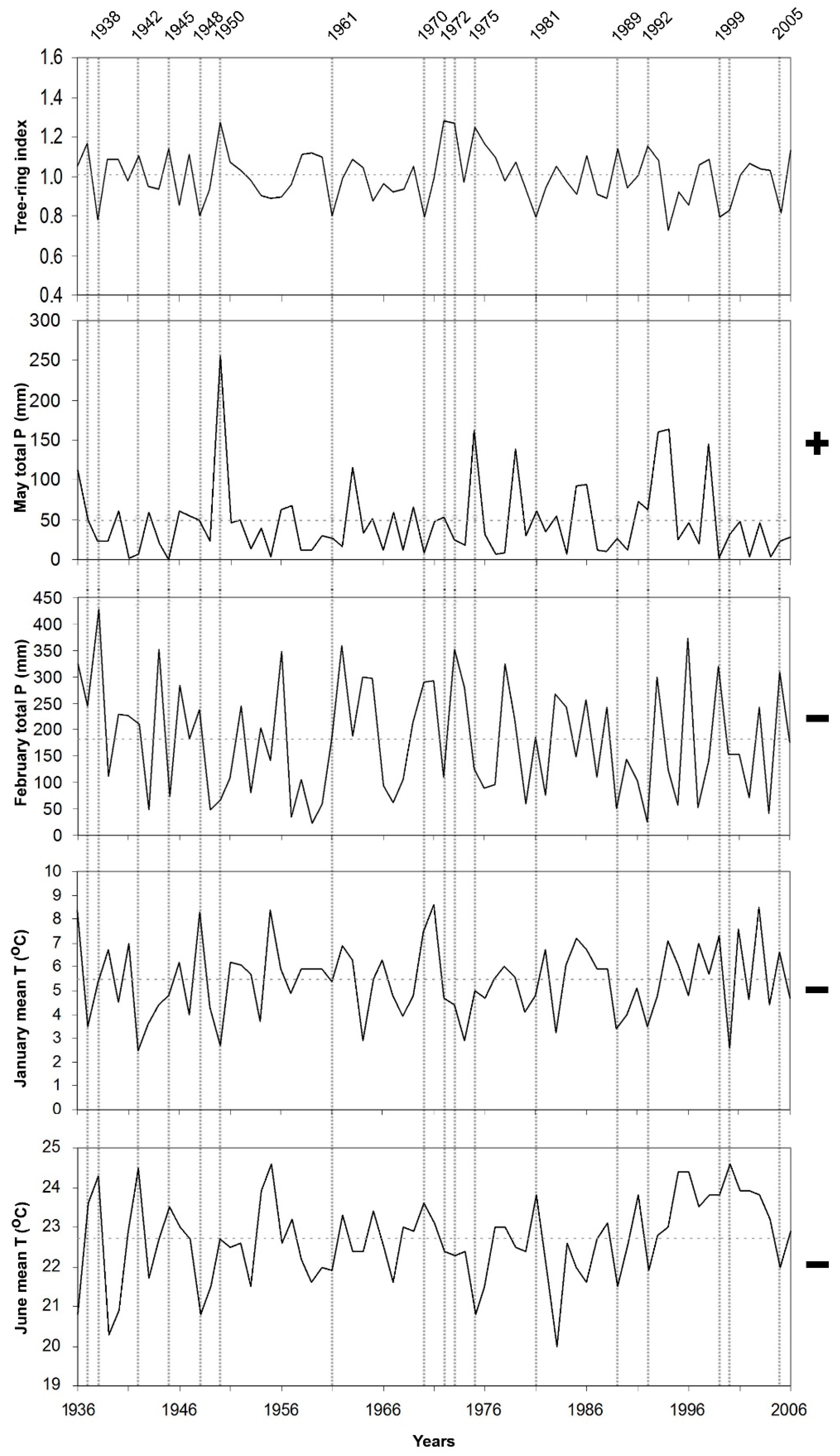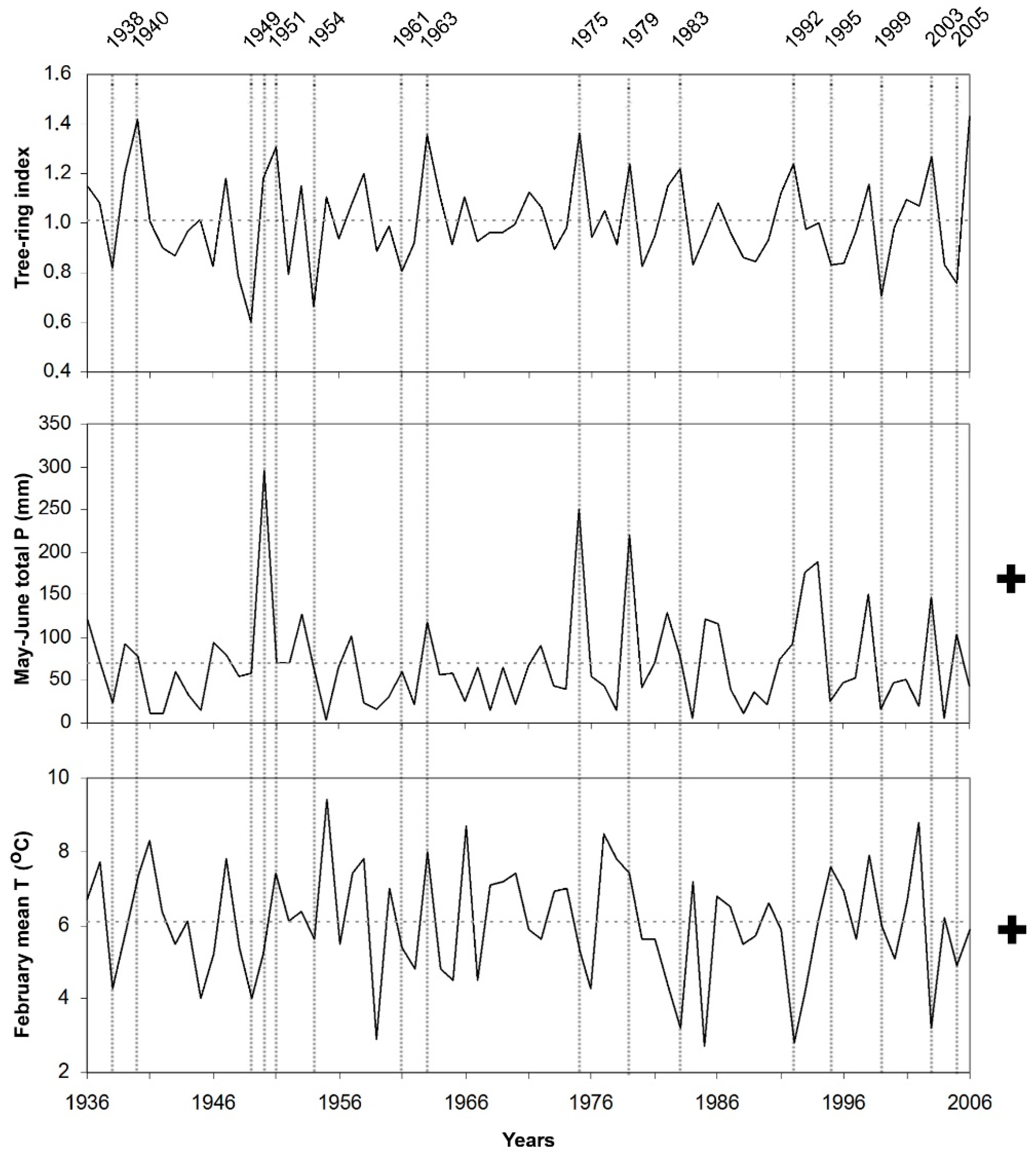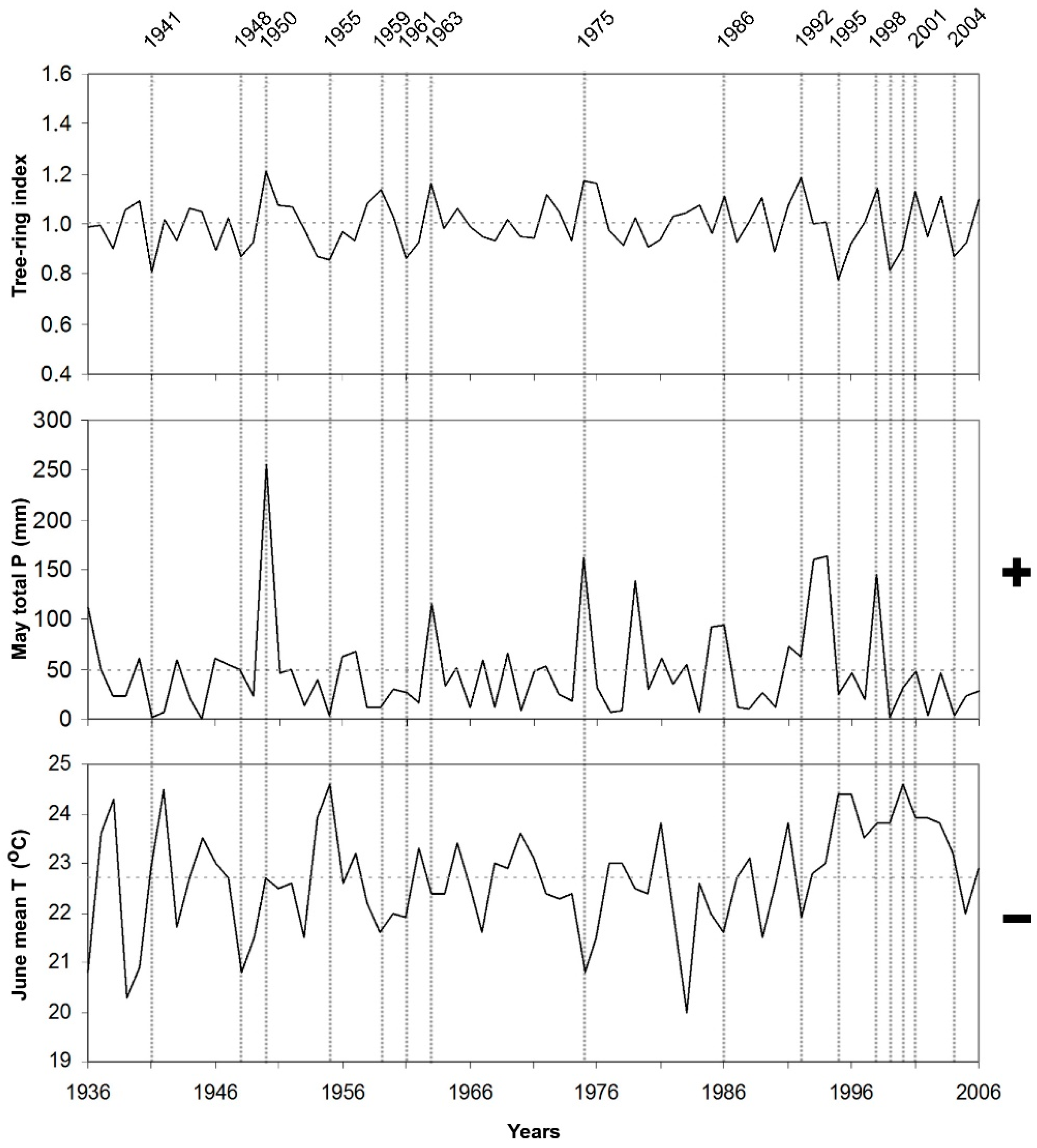Influence of Climate on Radial Growth of Black Pine on the Mountain Regions of Southwestern Turkey
Abstract
:1. Introduction
2. Results
3. Discussion
4. Materials and Methods
4.1. Study Area
4.2. Tree-Ring Chronologies and Climate Data
4.3. Identifying Relationship between Tree Growth and Climate
5. Conclusions
Author Contributions
Funding
Acknowledgments
Conflicts of Interest
References
- Fritts, H.C. Relationship of ring widths in arid-site conifers to variations in monthly temperature and precipitation. Ecol. Monogr. 1974, 44, 411–440. [Google Scholar] [CrossRef]
- Fritts, H.C. Tree Rings and Climate; Academic Press: New York, NY, USA, 1976. [Google Scholar]
- Oberhuber, W.; Stumböck, M.; Kofler, W. Climate-tree-growth relationships of Scots pine stands (Pinus sylvestris L.) exposed to soil dryness. Trees 1998, 13, 19–27. [Google Scholar] [CrossRef]
- Martin-Benito, D.; Beeckman, H.; Canellas, I. Influence of drought on tree rings and tracheid features of Pinus nigra and Pinus sylvestris in a mesic Mediterranean forest. Eur. J. For. Res. 2013, 132, 33–45. [Google Scholar] [CrossRef]
- Misi, D.; Puchałka, R.; Pearson, C.; Robertson, I.; Koprowski, M. Differences in the Climate-Growth Relationship of Scots Pine: A Case Study from Poland and Hungary. Forests 2019, 10, 243. [Google Scholar] [CrossRef]
- Martin-Benito, D.; Gea-Izquierdo, G.; del Rio, M.; Canellas, I. Long-term trends in dominant-height growth of black pine using dynamic models. For. Ecol. Manag. 2008, 256, 1230–1238. [Google Scholar] [CrossRef]
- Akkemik, Ü. Dendrochronological investigations in two monumental Pinus nigra Arn. stands near Antalya (Turkey). In Proceedings of the International Scientific Conference—75 Years University Forestry Education in Bulgaria, Sofia, Bulgaria, 15–16 June 2000; pp. 179–187. [Google Scholar]
- Köse, N.; Akkemik, Ü.; Dalfes, H.N.; Özeren, M.S.; Tolunay, D. Tree-ring growth of Pinus nigra Arn. subsp. pallasiana under different climate conditions throughout western Anatolia. Dendrochronologia 2012, 30, 295–301. [Google Scholar]
- Martin-Benito, D.; Cherubini, P.; del Rio, M.; Canellas, I. Growth response to climate and drought in Pinus nigra Arn. Trees of different crown classes. Trees 2008, 22, 363–373. [Google Scholar] [CrossRef]
- Lebourgeois, F. Climatic signals in earlywood, latewood and total ring width of Corsican pine from western France. Ann. For. Sci. 2000, 57, 155–164. [Google Scholar] [CrossRef] [Green Version]
- Teets, A.; Fraver, S.; Weiskittel, A.R.; Hollinger, D.Y. Quantifying climate–growth relationships at the stand level in a mature mixed-species conifer forest. Glob. Chang. Biol. 2018, 24, 1–16. [Google Scholar] [CrossRef]
- Fan, Z.; Brauning, A.; Cao, K.; Zhu, S. Growth–climate responses of high-elevation conifers in the central Hengduan Mountains, southwestern China. For. Ecol. Manag. 2009, 258, 306–313. [Google Scholar] [CrossRef]
- Mazza, G.; Gallucci, V.; Manetti, M.C.; Urbinati, C. Climate–growth relationships of silver fir (Abies alba Mill.) in marginal populations of Central Italy. Dendrochronologia 2014, 32, 181–190. [Google Scholar] [CrossRef]
- Zhang, Y.; Yin, D.; Sun, M.; Wang, H.; Tian, K.; Xiao, D.; Zhang, W. Variations of Climate—Growth Response of Major Conifers at Upper Distributional Limits in Shika Snow Mountain, Northwestern Yunnan Plateau, China. Forests 2017, 8, 377. [Google Scholar] [CrossRef]
- Köse, N. Climatic Factors Affecting Tree-Ring Growth of Abies nordmanniana (Stev.) Spach. subsp. bornmuelleriana (Mattf.) Coode&Cullen from Kastamonu, Turkey. İstanbul Üniversitesi Orman Fakültesi Dergisi 2012, 62, 71–83. [Google Scholar]
- Yang, B.; He, M.; Melvin, T.M.; Zhao, Y.; Briffa, K.R. Climate Control on Tree Growth at the Upper and Lower Treelines: A Case Study in the Qilian Mountains, Tibetan Plateau. PLoS ONE 2013, 8, e69065. [Google Scholar] [CrossRef] [PubMed]
- Türkeş, M. Klimatoloji ve Meteoroloji; Kriter Yayınları: İstanbul, Turkey, 2010. [Google Scholar]
- Erlat, E.; Türkeş, M. Analysis of observed variability and trends in numbers of frost days in Turkey for the period 1950–2010. Int. J. Climatol. 2011, 32, 1889–1898. [Google Scholar] [CrossRef]
- Schweingruber, F.H.; Kairiukstis, L.; Shiyatov, S. Sample Selection. In Methods of Dendrochronology: Applications in the Environmental Sciences; Cook, E., Kairiukstis, L.A., Eds.; Kluwer Academic Publishers: Amsterdam, The Netherlands, 1990; pp. 23–35. [Google Scholar]
- Akkemik, Ü. Dendrokronoloji. İlkeleri, Biyolojik Temelleri, Yöntemleri ve Uygulama Alanları; Yayın No: 4484/479; İstanbul Üniversitesi Orman Fakültesi: İstanbul, Turkey, 2004; ISBN 975-404-730-8. [Google Scholar]
- Yaltırık, F. Dendroloji Ders Kitabı I Gymnospermae (Açık Tohumlular); Yayın No: 3443/386; İstanbul Üniversitesi Orman Fakültesi Yayınları: İstanbul, Turkey, 1988. [Google Scholar]
- Yaltırık, F.; Akkemik, Ü. Türkiye’nin Doğal Gymnospermleri (Açık Tohumlular); T.C. Çevre ve Orman Bakanlığı Orman Genel Müdürlüğü Yayınları: Ankara, Turkey, 2011; ISBN 978-605-60143-1-4. [Google Scholar]
- Akkemik, Ü.; Aras, A. Reconstruction (1689–1994) of April–August precipitation in the southern part of central Turkey. Int. J. Climatol. 2005, 25, 537–548. [Google Scholar] [CrossRef]
- Akkemik, Ü.; D’Arrigo, R.; Cherubini, P.; Köse, N.; Jacoby, G.C. Tree-ring reconstructions of precipitation and streamflow for north-western Turkey. Int. J. Climatol. 2008, 28, 173–183. [Google Scholar] [CrossRef]
- Köse, N.; Akkemik, Ü.; Dalfes, H.N. Anadolu’nun Iklim Tarihinin Son 500 Yılı: Dendroklimatolojik Ilk Sonuçlar. In Proceedings of the Türkiye Kuvaterner Sempozyumu-TURQUA-V, İstanbul, Turkey, 2–3 June 2005; pp. 136–142. [Google Scholar]
- Köse, N.; Akkemik, Ü.; Dalfes, H.N.; Özeren, M.S. Tree-Ring Reconstructions of May-June Precipitation of Western Anatolia. Quat. Res. 2011, 75, 438–450. [Google Scholar] [CrossRef]
- Köse, N.; Akkemik, Ü.; Güner, H.T.; Dalfes, H.N.; Grissino-Mayer, H.D.; Özeren, M.S.; Kındap, T. An improved reconstruction of May-June precipitation using tree-ring data from western Turkey and its links to volcanic eruptions. Int. J. Biometeorol. 2013, 57, 691–701. [Google Scholar] [CrossRef]
- Köse, N.; Güner, H.T.; Harley, G.L.; Guiot, J. Spring temperature variability over Turkey since 1800CE reconstructed from a broad network of tree-ring data. Clim. Past 2017, 13, 1–15. [Google Scholar] [CrossRef]
- Güner, H.T.; Köse, N.; Harley, G.L. A 200-year reconstruction of Kocasu River (Sakarya River Basin, Turkey) streamflow derived from a tree-ring network. Int. J. Biometeorol. 2017, 61, 427–437. [Google Scholar] [CrossRef] [PubMed]
- Janssen, E.; Kint, V.; Bontemps, J.D.; Özkan, K.; Mert, A.; Köse, N.; İçel, B.; Muys, B. Recent growth trends of black pine (Pinus nigra J.F. Arnold) in the eastern Mediterranean. For. Ecol. Manag. 2018, 412, 21–28. [Google Scholar] [CrossRef]
- Martin-Benito, D.; Kint, V.; del Río, M.; Muys, B.; Cañellas, I. Growth responses of West-Mediterranean Pinus nigra to climate change are modulated by competition and productivity: Past trends and future perspectives. For. Ecol. Manag. 2011, 262, 1030–1040. [Google Scholar] [CrossRef]
- Hughes, M.K.; Kuniholm, P.I.; Garfin, G.M.; Latini, C.; Eischeid, J. Aegean treering signature years explained. Tree-Ring Res. 2001, 57, 67–73. [Google Scholar]
- D’Arrigo, R.; Cullen, H.M. A 350-year (AD 1628–1980) reconstruction of Turkish precipitation. Dendrochronologia 2001, 19, 169–177. [Google Scholar]
- Dağdeviren, N. Kazdağları’nda Doğal Yetişen Gymnosperm Taksonları Üzerinde Dendrokronolojik Araştırmalar. Master’s Thesis, Institute of Graduate Studies in Sciences, İstanbul, Turkey, 2002. [Google Scholar]
- Touchan, R.; Xoplaki, E.; Funchouser, G.; Luterbacher, J.; Hughes, M.K.; Erkan, N.; Akkemik, Ü.; Stephan, J. Reconstruction of spring/summer precipitation for the Eastern Mediterranean from tree-ring widths and its connection to large-scale atmospheric circulation. Clim. Dyn. 2005, 25, 75–98. [Google Scholar] [CrossRef]
- Touchan, R.; Funkhouser, G.; Hughes, M.K.; Erkan, N. Standardized precipitation index reconstructed from Turkish ring widths. Clim. Chang. 2005, 72, 339–353. [Google Scholar] [CrossRef]
- Touchan, R.; Akkemik, Ü.; Hughes, M.K.; Erkan, N. May-June precipitation reconstruction of southwestern Anatolia, Turkey during the last 900 years from tree rings. Quat. Res. 2007, 68, 196–202. [Google Scholar] [CrossRef]
- Thomsen, G. Response to winter precipitation in ring-width chronologies of Pinus sylvestris L. from the northwestern Siberian Plain, Russia. Tree-Ring Res. 2001, 57, 15–29. [Google Scholar]
- Tranquillini, W. Frost-drought and its ecological significance. In Physiological Plant Ecology II. Encyclopedia of Plant Physiology (New Series); Lange, O.L., Nobel, P.S., Osmond, C.B., Ziegler, H., Eds.; Springer: Berlin/Heidelberg, Germany, 1982; Volume 12. [Google Scholar]
- Mehta, A.V.; Yang, S. Precipitation climatology over Mediterranean Basin from ten years of TRMM measurements. Adv. Geosci. 2008, 17, 87–91. [Google Scholar] [CrossRef] [Green Version]
- Garcies, L.; Homar, V. An optimized ensemble sensitivity climatology of Mediterranean intense cyclones. Nat. Hazards Earth Syst. Sci. 2010, 10, 2441–2450. [Google Scholar] [CrossRef]
- Campins, J.; Genoves, A.; Picornell, M.A.; Jansa, A. Climatology of Mediterranean cyclones using the ERA-40 dataset. Int. J. Climatol. 2011, 31, 1596–1614. [Google Scholar] [CrossRef]
- Doğan, M. Sandıras Dağı’nda (Muğla) buzullaşma ve buzul şekilleri. Ege Coğrafya Dergisi 2011, 20, 29–52. [Google Scholar]
- Doğan, M.; Köse, N. Four new tree-ring chronologies from old black pine forests of Sandıras Mountain (Mugla, Turkey). J. Fac. For. Istanb. Univ. 2015, 65, 1–16. [Google Scholar] [CrossRef]
- Stokes, M.A.; Smiley, T.L. An Introduction to Tree-Ring Dating; University of Chicago Press: Chicago, IL, USA, 1968. [Google Scholar]
- Yamaguchi, D.K. A simple method for cross-dating increment cores from living trees. Can. J. For. Res. 1991, 21, 414–416. [Google Scholar] [CrossRef]
- Holmes, R.L. Computer-assisted quality control in tree-ring dating and measurement. Tree-Ring Bull. 1983, 43, 69–78. [Google Scholar]
- Grissino-Mayer, H.D. Evaluating crossdating accuracy: A manual and tutorial for the computer program COFECHA. Tree-Ring Res. 2001, 57, 205–221. [Google Scholar]
- Cook, E. A Time series Analysis Approach to Tree-Ring Standardization. Ph.D. Thesis, University of Arizona, Tucson, AZ, USA, 1985. [Google Scholar]
- Cook, E.; Briffa, K.; Shiyatov, S.; Mazepa, V. Tree-ring standardization and growthtrend estimation. In Methods of Dendrochronology: Applications in The Environmental Sciences; Cook, E., Kairiukstis, L.A., Eds.; Kluwer Academic Publishers: Amsterdam, The Netherlands, 1990; pp. 104–122. [Google Scholar]
- Cook, E.; Shiyatov, S.; Mazepa, V. Estimation of the mean chronology. In Methods of Dendrochronology: Applications in the Environmental Sciences; Cook, E., Kairiukstis, L.A., Eds.; Kluwer Academic Publishers: Amsterdam, The Netherlands, 1990; pp. 123–132. [Google Scholar]
- Biondi, F.; Waikul, K. DENDROCLIM2002: A C++ program for statistical calibration of climate signals in tree-ring chronologies. Comput. Geosci. 2004, 30, 303–311. [Google Scholar] [CrossRef]









| Site Code | Site Name | No. of the Trees/Cores | Aspect | Elevation | Time Span | Mean Sensitivity | Variance in First Eigenvector | |
|---|---|---|---|---|---|---|---|---|
| South slope of Sandıras Mountain | AGA | Köyceğiz (Ağla) lower limit of black pine forest | 15/31 | S | 1310–1370 | 1770–2010 | 0.22 | 47.37 |
| AGU | Köyceğiz (Ağla) upper limit of black pine forest | 16/33 | S and SW | 1815–1890 | 1712–2010 | 0.16 | 33.98 | |
| North slope of Sandıras Mountain | CIA | Beyağaç (Eksere/Çiçekli) lower limit of black pine forest | 16/32 | S | 1395–1425 | 1427–2010 | 0.27 | 56.15 |
| CIU | Beyağaç (Eksere/Çiçekli) upper limit of black pine forest | 16/34 | S | 1805–1850 | 1191–2010 | 0.14 | 23.86 |
© 2019 by the authors. Licensee MDPI, Basel, Switzerland. This article is an open access article distributed under the terms and conditions of the Creative Commons Attribution (CC BY) license (http://creativecommons.org/licenses/by/4.0/).
Share and Cite
Doğan, M.; Köse, N. Influence of Climate on Radial Growth of Black Pine on the Mountain Regions of Southwestern Turkey. Plants 2019, 8, 276. https://doi.org/10.3390/plants8080276
Doğan M, Köse N. Influence of Climate on Radial Growth of Black Pine on the Mountain Regions of Southwestern Turkey. Plants. 2019; 8(8):276. https://doi.org/10.3390/plants8080276
Chicago/Turabian StyleDoğan, Mehmet, and Nesibe Köse. 2019. "Influence of Climate on Radial Growth of Black Pine on the Mountain Regions of Southwestern Turkey" Plants 8, no. 8: 276. https://doi.org/10.3390/plants8080276





